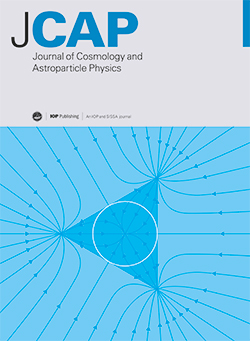H.E.S.S. programme searching for VHE gamma rays associated with FRBs
IF 5.9
2区 物理与天体物理
Q1 ASTRONOMY & ASTROPHYSICS
Journal of Cosmology and Astroparticle Physics
Pub Date : 2025-07-27
DOI:10.1088/1475-7516/2025/07/086
引用次数: 0
Abstract
Fast Radio Bursts (FRBs) are highly energetic, extremely short-lived bursts of radio flashes. Despite extensive research, the exact cause of these outbursts remains speculative. The high luminosity, short duration, and high dispersion measure of these events suggest they result from extreme, high-energy extragalactic sources, such as highly magnetized and rapidly spinning neutron stars known as magnetars. The number of detected FRBs, including repeating ones, has grown rapidly in recent years. Except for FRB 20200428D, and FRB-like radio burst that is associated to Galactic magnetar SGR 1935+2154, no multi-wavelength counterpart to any FRB has been detected yet. The High Energy Stereoscopic System (H.E.S.S.) telescope has developed a program to follow up FRBs searching for their gamma-ray counterparts, helping to uncover the nature of FRBs and FRB sources. This paper provides an overview of the searches for FRB sources conducted by H.E.S.S., including follow-up observations and simultaneous multi-wavelength campaigns with radio and X-ray observatories. Among the FRB sources observed by H.E.S.S., nine are localized with redshifts ranging between 0.11 and 0.492 from 2015 to 2022. No significant very high energy (VHE) emission was detected during these observations. We report constraints on the VHE luminosity ranging from 1044 erg s-1 and 1048 erg s-1, placing limits on the FRB's region persistent VHE emission and potential FRB afterglow emission across timescales from hours to years.H.E.S.S.项目寻找与快速射电暴相关的甚高频伽马射线
快速射电暴(frb)是一种能量极高、寿命极短的射电暴。尽管有广泛的研究,这些爆发的确切原因仍然是推测。这些事件的高亮度、短持续时间和高色散测量表明,它们是由极端的、高能的河外源造成的,比如高磁化和快速旋转的中子星,即磁星。近年来,探测到的快速射电暴数量(包括重复射电暴)迅速增长。除了FRB 20200428D和与星系磁星SGR 1935+2154有关的类似FRB的射电暴外,目前还没有发现任何与FRB对应的多波长射电暴。高能立体系统(H.E.S.S.)望远镜已经开发了一个程序来跟踪快速射电暴,寻找它们的伽马射线对应物,帮助揭示快速射电暴的性质和来源。本文概述了h.e.s.s.对快速射电暴源的搜索,包括后续观测和与射电和x射线天文台同时进行的多波长运动。在2015年至2022年期间,H.E.S.S观测到的FRB源中,有9个定位红移范围在0.11 ~ 0.492之间。在这些观测中没有探测到显著的甚高能量(VHE)发射。我们报告了在1044 erg - s-1和1048 erg - s-1之间的VHE亮度限制,对FRB区域持续的VHE发射和潜在的FRB余辉发射进行了限制,时间尺度从小时到年不等。
本文章由计算机程序翻译,如有差异,请以英文原文为准。
求助全文
约1分钟内获得全文
求助全文
来源期刊

Journal of Cosmology and Astroparticle Physics
地学天文-天文与天体物理
CiteScore
10.20
自引率
23.40%
发文量
632
审稿时长
1 months
期刊介绍:
Journal of Cosmology and Astroparticle Physics (JCAP) encompasses theoretical, observational and experimental areas as well as computation and simulation. The journal covers the latest developments in the theory of all fundamental interactions and their cosmological implications (e.g. M-theory and cosmology, brane cosmology). JCAP''s coverage also includes topics such as formation, dynamics and clustering of galaxies, pre-galactic star formation, x-ray astronomy, radio astronomy, gravitational lensing, active galactic nuclei, intergalactic and interstellar matter.
 求助内容:
求助内容: 应助结果提醒方式:
应助结果提醒方式:


